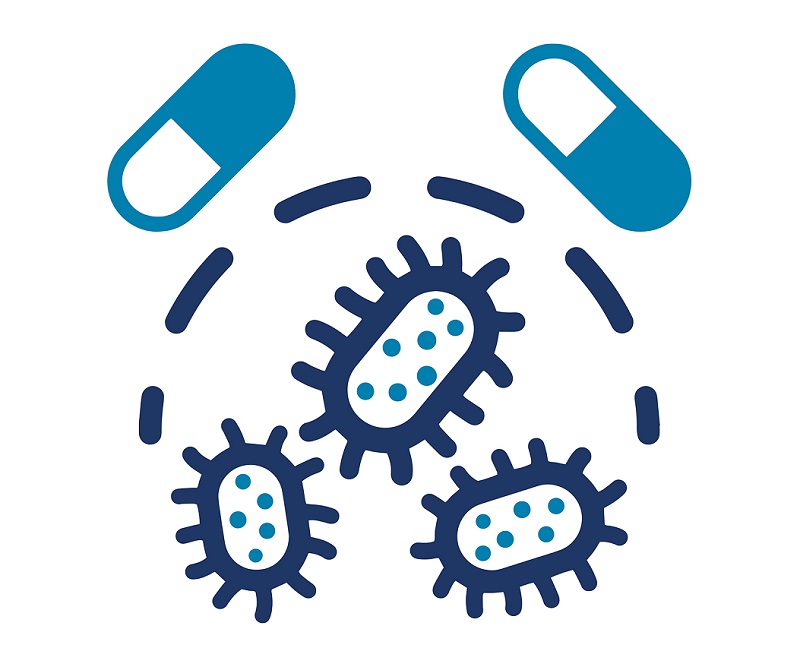Antibiotic resistance is at a crisis point

Antibiotic resistance poses one of the most important health challenges of the 21st century. And time has already run out to stop its dire consequences.
The rise of multidrug-resistant bacteria has already led to a significant increase in human disease and death. The U.S. Centers for Disease Control and Prevention estimates that approximately 2.8 million people worldwide are infected with antibiotic-resistant bacteria, accounting for 35,000 deaths each year in the U.S. and 700,000 deaths around the globe.
In order to survive, bacteria naturally evolve to become resistant to the drugs that kill them. They do this via two methods: genetic mutation and horizontal gene transfer.
Genetic mutation occurs when the bacteria's DNA, or genetic material, randomly changes. If these changes let the bacteria evade an antibiotic that would have otherwise killed it, it will be able to survive and pass on this resistance when it reproduces. Over time, the proportion of resistant bacteria will increase as nonresistant bacteria are killed by the antibiotic. Eventually, the drug will no longer work on these bacteria because they all have the mutation for resistance.
The other method bacteria use is horizontal gene transfer. Here, one bacterium acquires resistance genes from another source, either through their environment or directly from another bacterium or bacterial virus.
But the antibiotic resistance crisis is largely anthropogenic, or human-made. Factors include the overuse and abuse of antibiotics, as well as a lack of regulations and enforcement pertaining to proper use. For example, doctors prescribing antibiotics for nonbacterial infections and patients not completing their prescribed course of treatment give bacteria the chance to evolve resistance.
There are also no regulations on antibiotic use in animal agriculture, including controlling leakage into the surrounding environment. Only recently has there been a push for more antibiotic oversight in agriculture in the U.S. As an October 2021 report by the National Academies of Sciences, Engineering and Medicine noted, antibiotic resistance is an issue that connects human, environmental and animal health. Effectively addressing one facet requires addressing the others.
One of the major reasons for the resistance crisis is the stalling of antibiotic development over the past 34 years. Scientists call this the antibiotic discovery void.
Researchers discovered the last class of highly effective antibiotics in 1987. Since then, no new antibiotics have made it out of the lab. This is partly because there was no financial incentive for the pharmaceutical industry to invest in further research and development. Antibiotics at the time were also effective at what they did. Unlike chronic diseases like hypertension and diabetes, bacterial infections don't typically require ongoing treatment, and so have a lower return on investment.
In France, Pr Céline Pulcini declares in his editorial on the prevention of infections and antibiotic resistance (Antibiotic resistance in France in 2021: a threat under surveillance - November 2021): "The fight against antibiotic resistance - and its consequences on health - is based on two fundamental principles: the prevention and control of infections (especially those associated with healthcare) and the proper use of antibiotics. Preventing infections and reducing the transmission of infectious agents and resistance genes makes it possible to reduce the risk of antibiotic resistance, by reducing the opportunities to use antibiotics and by limiting the spread of bacteria, viruses and resistance genes. The correct use of antibiotics minimizes the emergence of resistance.
Santé public France has published a dossier concerning "EVOLUTION OF ANTIBIOTIC CONSUMPTION IN THE AMBULATORY SECTOR IN FRANCE 2010-2020. WHAT IS THE IMPACT OF THE COVID-19 PANDEMIC? "
This article is devoted to the analysis of antibiotic consumption and prescriptions in the ambulatory sector, addressing their evolution during the period 2010-2020 based on data from the National Health Data System.
It also measures the significant impact of the 2020 COVID-19 pandemic on antibiotic use. In 2020, we observed a 17% decrease in consumption, expressed in the number of Defined Daily Doses, and an 18% decrease in the number of prescriptions compared to what was expected for the year.
Enhanced hygiene measures and social distancing measures, as well as periods of lockdown, have all contributed to a slower transmission of bacterial and viral infections. In addition, the pandemic had the effect of restricting the number of medical consultations and thus the number of prescriptions.
The results presented herein also account for the age and sex of patients: it was thus possible to observe that women received more antibiotic prescriptions than men did. Moreover, it was in the youngest age groups that prescriptions fell the most between 2010 and 2020.
In addition, general practitioners were the main source of antibiotic prescriptions, but their rate of prescription decreased during the period. It remains to establish, over the next few years, whether the pandemic has caused a shift in behaviour and contributed to increased compliance with hygiene measures. If this is the case, lower antibiotic use could be observed in the long term.
Many scientists agree that addressing antibiotic resistance requires more than just responsible use by individuals. The government, academia and pharmaceutical companies need to partner together in order to effectively tackle this crisis.
To find out more, please read the PHARMAnetwork dossier published in issue 50 of PHARMAnetwork magazine (September 2021): ANTIMICROBIAL RESISTANCE : THE SILENT PANDEMIC
RELATED ANTIMICROBIAL RESISTANCE : THE SILENT PANDEMIC
